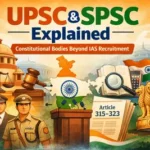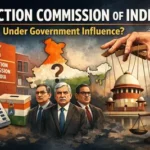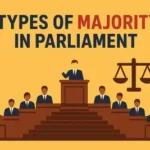
India’s national awards recognize excellence in public service, science, literature, cinema, sport, and valor in action, and they are more than ceremonial accolades. They symbolize the national award categories (the Bharat Ratna, the Param Vir Chakra, the Padma Awards, the National Film Awards) and articulate the values that Indian society embodies—service, ingenuity, courage, creativity, and contributing to country.
For UPSC aspirants, national awards matter as indicators of India’s cultural essence and shifting governance priorities that go beyond pin-on-the-map data points. You will likely refer to national awards in Prelims questions (match-the-following, organizing bodies, most recent award recipients) as well as in major (GS-I and GS-II) and ethics papers (public service and role models) in your answers, and even discuss them in interview conversations (awareness of and opinion on contemporary figures featured with national awards)
Introduction: India’s National Awards
The National Awards in India are official acknowledgments given by the State recognizing significant contributions in many fields including public service, scientific contributions, literature, cinema, sport, or an exceptional act of bravery. These National Awards should not only be viewed as symbols of prestige but as formal recognition of spirit to encourage, motivate and sustain excellence nationally.
“A country that recognizes merit anywhere, nurtures the concepts of honesty, originality, and bravery.”
This statement summarizes why awards are important: they reinforce national values and showcase the diversity of talent, and an individual excellence is a betterment for collective excellence.
Examples of Prominent National Awards in India
Here are just a few prominent awards that you may encounter as a future UPSC aspirant:
- Bharat Ratna – The highest civilian award in India for exceptional service in any field.
- Padma Awards (Padma Vibhushan, Padma Bhushan, Padma Shri) – consist of the Padma Vibhushan, Padma Bhushan and Padma Shri which presented for distinguished and exceptional contributions in various fields.
- Param Vir Chakra – The highest military honour in India for exceptional bravery in the face of the enemy.
- Shanti Swarup Bhatnagar Prize – Outstanding contributions in research science and technology.
- National Film Awards – For contributions within cinema of India.
- Sahitya Akademi Award – Exceptional writing in literature.
- Arjuna Award – Recognising outstanding achievement in national sport.
Below, you’ll find a complete list of India’s major national awards, their criteria, fields, and organizing bodies—a one-stop reference every UPSC aspirant should keep handy.
| Award Name | Criteria | Starting Year | Field | Organizing Body |
| Bharat Ratna | Exceptional service/performance of highest order in any field of human endeavor | 1954 | Civilian (all fields) | President of India on PM’s recommendation |
| Padma Vibhushan | Exceptional and distinguished service | 1954 | Civilian | Ministry of Home Affairs |
| Padma Bhushan | Distinguished service of high order | 1954 | Civilian | Ministry of Home Affairs |
| Padma Shri | Distinguished service in any field | 1954 | Civilian | Ministry of Home Affairs |
| National Film Awards | Excellence in cinema, acting, direction, technical fields | 1954 | Cinema | Directorate of Film Festivals (Ministry of I&B) |
| Sahitya Akademi Award | Literary merit in any recognized Indian language | 1955 | Literature | Sahitya Akademi |
| Jnanpith Award | Outstanding literary contribution in Indian languages | 1965 | Literature | Bharatiya Jnanpith Trust |
| Sangeet Natak Akademi Award | Eminence in performing arts (music, dance, drama) | 1952 | Performing Arts | Sangeet Natak Akademi |
| Lalit Kala Akademi Award | Excellence in visual arts | 1955 | Visual Arts | Lalit Kala Akademi |
| Shanti Swarup Bhatnagar Prize | Outstanding scientific research under age 45 | 1958 | Science & Technology | CSIR |
| National Technology Awards | Breakthroughs in innovation and technology commercialization | 1999 | Technology & Innovation | Technology Development Board (Ministry of S&T) |
| Young Scientist Award | Innovative research by scientists under 35 | 1987 | Science | Indian National Science Academy (INSA) |
| Major Dhyan Chand Khel Ratna Award | Most outstanding sports performance over 4 years | 1991–92 | Sports | Ministry of Youth Affairs and Sports |
| Arjuna Award | Consistent outstanding performance for 4 years | 1961 | Sports | Ministry of Youth Affairs and Sports |
| Dronacharya Award | Excellence in coaching in sports | 1985 | Sports Coaching | Ministry of Youth Affairs and Sports |
| Tenzing Norgay National Adventure Award | Outstanding achievements in adventure sports | 1993 | Adventure | Ministry of Youth Affairs and Sports |
| Param Vir Chakra | Most conspicuous bravery in the presence of the enemy | 1950 | Wartime Gallantry | Ministry of Defence |
| Ashoka Chakra | Bravery away from battlefield (peacetime) | 1952 | Peacetime Gallantry | President of India |
| Shaurya Chakra | Gallant action in peacetime | 1952 | Peacetime Gallantry | Ministry of Defence |
| Kirti Chakra | Courageous action not in direct war | 1952 | Peacetime Gallantry | Ministry of Defence |
| Swachh Survekshan Awards | Best performing cities and states in cleanliness | 2016 | Urban Sanitation | Ministry of Housing and Urban Affairs |
| Bharat Gaurav Award (Indian Railways) | Lifetime contribution to Indian culture & values | 2022 | Public Service / Culture | Ministry of Railways (varies by event) |
Download the pdf from here-
Review: 2025 National Film Awards
On August 1, 2025, perhaps unsurprisingly given the times we live in, the 71st National Film Awards were announced, which in fact hailed the multiplicity and joint storytelling of Indian Cinema. The headline of the book was the rather unexpected—but symbolic—joint winners for Best Actor:
- Shah Rukh Khan – for Jawan: The celluloid chapter of World Superstar with regards to Indian national recognition marks this amazing actor ‘first’ National Film Award in a 33-year career (which includes his Friday film, Jawan), after an immense, multilayered performance as part of the context of a commercial blockbuster.
- Vikrant Massey – for 12th Fail: An extraordinary performance that connected with aspirational youth, especially civil services aspirants.
There were other big winners too:
Best Feature Film
12th Fail
A story of resilience, failure and success with a clear connection to UPSC aspirants and dreamers everywhere in the country.
For Best Actress
Rani Mukerji – for Mrs Chatterjee Vs Norway, Where a mother fights against a foreign system, grappling with identity and justice.
Best Hindi Film
Kathal: A Jackfruit Mystery
a satire on bureaucracy and social priorities.
These films are not just triumphs of cinema, but they are also case studies for UPSC GS papers. Arguably, it is more evident in ethics (from the past 2 years), or social justice (like in the case of Kathal); or gender issues; or even public administration.
Central Board of Film Certification (CBFC)
The Central Board of Film Certification (CBFC) is a statutory body under the aegis of the Ministry of Information and Broadcasting, Government of India. It is popularly known as the Censor Board and is the regulatory authority of public exhibition of films in India under the provisions of the Cinematograph Act, 1952.
Mandate: Granting certificates to films for public exhibition.
Headquarters: Mumbai.
Motto: “Sanskriti, Suraksha aur Samvedana” (Culture, Safety, and Sensitivity).
All the national film awards nominees as well as winners were the part of movies certified by CBFC between Jan 1 and Dec 31, 2023. Also, Recently, Kamal Hassan’s movie – “Thug Life” came under the scrutiny of CBFC which makes it more important.
Types of Certificates Issued by CBFC
U Suitable for people of all ages.
UA Suitable for children above 12 with adult supervision.-
A Restricted to adult audiences (18+).
S Restricted to a particular profession or class (like doctors).
CBFC and the National Film Awards
While CBFC does not select or nominate films for the National Film Awards, it is a mandatory criterion for eligibility:
- From now on, Only certified films (feature or non-feature) are allowed to compete in the National Film Awards.
- Furthermore, Films (feature/non-feature) with ‘U’ or ‘UA’ certificates should be favoured in the categories of Best Children’s Film or Best Family Film etc.
Thus, CBFC acts as a gatekeeper by making sure that only certified films compete for awards, screenings etc.
Constitutional Undertone of National Awards: Do They Traverse the Right to Equality?
At first glance, the functional aspect of national awards which provide honorifics and public recognition could infringe Article 18 of the Indian Constitution, which barred the State from conferred titles (degree, dignity, title or honour) except military or academic designation. The Constitution-makers inserted Article 18 to prevent a titled aristocracy and uphold equality under Article 14.
However, national recognitions such as Padma Awards do not contort the above provisions in the Constitution.
Article 18(1) – Prohibition of Titles
“No title, other than honorific military or academic distinctions, shall be conferred by the State”
This means, the State cannot confer titles that create artificial hierarchies (e.g. “Sir” or “Raja”).
However, the State can confer awards that recognize merit and excellence, provided that there is no prefix or suffix for the recipient’s name.
Landmark case: Balaji Raghavan v. Union of India (1996)
This landmark judgment of the Supreme Court of India upheld the constitutional validity of awards like the Padma Awards for civilians, which included the following:
“National Awards do not amount to ‘titles’ for the purposes of Article 18 of the Constitution, so long as they are not used as prefixes or suffixes to names.”
Supreme Court of India
The key takeaways from the judgment:
- Padma Awards are constitutional: The Padma Awards provide recognition for individual merit and excellence, while avoiding a breach in the principle of equality.
- No privilege under law: These awards do not give recipients a special legal entitlement nor a special status under the law.
- No contravention of prohibition of titles: Courts have observed that recipients cannot utilize a title like “Padma Shri” or “Bharat Ratna” in their name (Dr. A.P.J. Abdul Kalam not Bharat Ratna Dr. A.P.J. Abdul Kalam)
Note: The Importance of this Case for the UPSC:
This case connects with Indian Polity (GS Paper II) as well as current affairs, therefore relating to ethics.
Download UPSC PYQ file from below.
Conclusion
India’s national awards are more than ceremonial distinctions—they are an expression of the nation’s values, desires, and constitutional spirit. Therefore, from the acknowledgment of acts of bravery to lasting success in the arts, sciences, and public service, these awards reflect the values that every civil servant is expected to reflect: integrity, service, and devotion to the nation.
For UPSC aspirants, knowing the history, constitutional relevance, selection process, and importance of national awards is important for more than just prelims or mains–it can help them take a larger step toward an understanding of India’s administrative and moral framework. Also, questions on national awards often appear frequently in both Prelims and Mains, making this knowledge both symbolic and practical.
In a meritocracy and democracy, national awards signify milestones in accomplishments–with national awards in mind to start securing for future bureaucrats to reflect and guard.
Download UPSC PYQ file from below.
Read more: National Awards: An UPSC Essential





